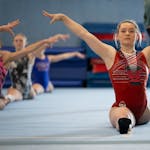BEIJING — When the NHL opted out of the Olympics in December because of COVID-19 issues that led to a slew of postponed games, USA Hockey turned to the college ranks to assemble its team.
The kids had no problems opting in, regardless of concerns at the time about how infected athletes would be treated at the Beijing Games.
"I just thought about the opportunity ahead of me," Gophers forward Matthew Knies said. "I think this is a once-in-a-lifetime [experience]. I don't think many kids get this chance to be on an Olympic team and to represent USA hockey."
The average age is 25, making this the youngest U.S. men's hockey Olympic team since the 1994 Games in Lillehammer, the last before professionals started playing. After adding NHL players to the roster, the U.S. won silver medals in 2002 and 2010 but hasn't medaled since.
The Wild's Bill Guerin was set to be general manager of Team USA, but when the NHL bailed out, the task of putting the team together fell to USA Hockey executive John Vanbiesbrouck and coach David Quinn. Their new group stepped up for the USA cause in Beijing instead of worrying about COVID protocols. Now that the team has been selected, arrived and had some practices under its belt — including a scrimmage against Canada on Monday — there's a significant question that has to be asked.
Do these kids realize what they have gotten themselves into?
This is not virus-related. Knies wasn't the only player who admitted he jumped at the chance to put on the Stars and Stripes. This is about life and hockey experience.
North Dakota defenseman Jake Sanderson, at 19 years and three months, is the youngest player on Team USA. Former Wild player Eric Staal is 37 years old, has played 17 NHL seasons, and will be Canada's captain, but the Canadians also have No. 1 overall pick Owen Power — 19 years and 2 months old — on defense. We're talking about a generation gap on all levels.
The Russian Olympic Committee is the defending gold medalist, winning four years ago as the Olympic Athletes from Russia, by beating Germany, normally not a hockey power.
The Russian roster is dominated by players from the Kontinental Hockey League, the best league outside the NHL. And several players return from that gold medal-winning team. They are grizzled veterans on this level.
Finland, the Czech Republic and Canada also have been given chances to win in Beijing. Aside from Canada, whose roster construction resembles that of Team USA, there are former NHL players and KHL stalwarts all over these rosters. China's team, almost booted from the Olympics for not being good enough, has seven Americans.
Four years ago, Team USA had 18 players aged 30 and over and just four college players — one of them current Wild forward Jordan Greenway. The collegians were its best players, and got the U.S. to the quarterfinals. This time, having learned a lesson, USA Hockey chose 15 college players. Many have world junior experience, but the team is hastily thrown together and will be totally unpredictable.
"I'm excited for the challenge," Gophers defenseman Brock Faber said, "and I think all the college guys are really looking forward to make a name for themselves just playing as best they can."
The kids can play. Forward Nathan Smith of Minnesota State Mankato is tied for the NCAA lead with 41 points on 15 goals and 26 assists. Michigan forward Matty Beniers was the second overall pick in the NHL draft, behind his college teammate Power. Sanderson, son of former NHLer Geoff Sanderson, was selected three spots after Beniers. Knies' reputation is growing with a strong freshman season. The Americans were a medal favorite at the world junior tournament before it was shut down in late December because of COVID issues.
Quinn's biggest challenge has been and will be to build chemistry and figure out his lines with just a couple of weeks of practice. If Team USA makes a run, it likely will be a different team by the end of the tournament than it was at the start, as players figure out how they fit in.
Team USA's roster also reflects the strength of the State of Hockey, as seven players were raised in Minnesota cities: Noah Cates (Stillwater), Faber (Maple Grove), Drew Helleson (Farmington), Sam Hentges (New Brighton), Ben Meyers (Delano), Aaron Ness (Roseau) and Nick Perbix (Elk River).
And there are six players 30 and older, so the Team USA doesn't totally resemble a day-care facility.
"That's the most exciting thing for me, as a younger player, is to be able to pick their brains," Knies said. "Get advice from them. Kind of be around professional athletes. I think that's gonna help me a lot on how to live my life. How to eat. How to sleep. Just kind of little things that I could pick up for them."
Perhaps there are lessons along the way on how to win the gold in a tournament without NHL players. The college kids will have to take some of these older guys to school if they want to be more than a long shot.






